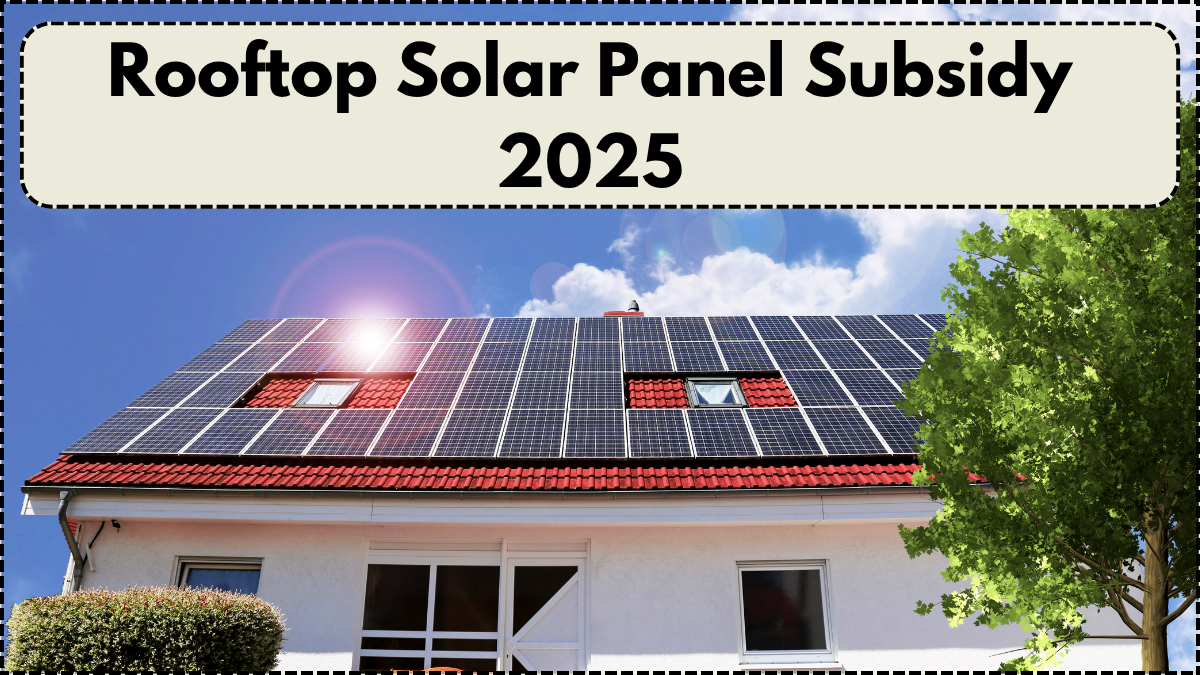In a major move to accelerate clean energy adoption, the government has launched an ambitious Solar Panel Subsidy India scheme for 2025. With a generous 40% subsidy offered on rooftop solar panel installations, this initiative aims to empower homeowners and MSMEs to transition to renewable energy while lowering electricity bills.
Under the revamped solar subsidy 2025 program, citizens across urban and rural areas can now access simplified, direct financial assistance for installing solar systems on their rooftops. The goal is to boost self-reliance in power consumption, reduce pressure on the grid, and cut carbon emissions in line with India’s climate commitments.
This scheme is part of the larger energy india campaign that supports decentralized solar energy generation, especially for small businesses, households, and cooperative housing societies.

What’s New in the 2025 Solar Subsidy Policy?
The Solar Panel Subsidy India scheme in 2025 introduces several new features compared to previous years. The government has increased transparency, eased documentation, and introduced a digital application process.
Key highlights of the 2025 policy:
-
40% subsidy for systems up to 3 kW
-
20% subsidy for systems between 3–10 kW
-
Special incentives for MSMEs in Tier-2 and Tier-3 cities
-
Direct Benefit Transfer (DBT) model — subsidy sent directly to applicant’s bank account
-
Online tracking via the National Rooftop Solar Portal
-
No middlemen required; applicants can apply directly
This move is expected to drive widespread adoption, especially among middle-class households and small-scale industries looking to reduce operational power costs under the energy india push.
Who Is Eligible for the Solar Panel Subsidy?
The solar subsidy 2025 is available to all Indian residents and registered MSMEs. However, there are specific eligibility criteria to ensure that the subsidy reaches genuine, energy-conscious users.
Eligibility criteria:
-
Must own the rooftop property (residential or commercial)
-
Installation capacity must not exceed 10 kW
-
Solar panels must be sourced from MNRE-approved vendors
-
Installation must follow DISCOM (Distribution Company) guidelines
-
Net metering must be enabled to track grid interaction
Let’s take a closer look at the subsidy structure in this table:
| System Size | Subsidy Offered | Beneficiary Type |
|---|---|---|
| Up to 3 kW | 40% of cost | Residential & MSMEs |
| 3 kW to 10 kW | 20% of cost | Residential & MSMEs |
| Above 10 kW | No subsidy | Large enterprises only |
This subsidy support can reduce upfront costs significantly, especially for families in semi-urban regions aiming for energy independence.
Benefits of Rooftop Solar Panels in 2025
With the Solar Panel Subsidy India policy in effect, thousands of Indian homes are expected to install rooftop solar this year. The advantages extend far beyond savings on electricity bills.
Top benefits include:
-
Massive cost reduction through the 40% solar subsidy 2025
-
Lower monthly electricity bills for 25+ years
-
Net metering advantages – sell unused power back to the grid
-
Eco-friendly energy that reduces your carbon footprint
-
Increased property value due to solar integration
-
Reduced dependence on grid supply during outages
Thanks to the government’s energy india push, many state DISCOMs are now offering faster net-metering approvals and simplified inspection procedures.
How to Apply for the 2025 Solar Subsidy
The application process for the solar subsidy 2025 has been streamlined to ensure maximum accessibility. Users no longer need agents or third-party help—everything is managed through the official portal.
Steps to apply:
-
Register on the National Rooftop Solar Portal
-
Submit property details and upload required documents
-
Select a vendor from the MNRE-approved list
-
Finalize capacity and get DISCOM’s technical approval
-
Install the system with net metering setup
-
Upload installation proof and inspection reports
-
Receive subsidy via Direct Benefit Transfer (DBT) within 30 days
The scheme has become a cornerstone of the Solar Panel Subsidy India initiative, encouraging citizens to take control of their power usage while supporting national clean energy goals.
Conclusion
The Solar Panel Subsidy India initiative of 2025 marks a turning point in India’s renewable energy journey. By offering up to 40% subsidy on rooftop installations, the government is making solar energy not just viable but attractive for homes and MSMEs alike.
With simplified online applications, transparent subsidy transfers, and improved vendor regulations, now is the best time to go solar. The solar subsidy 2025 is not just about savings—it’s about making every citizen a participant in the country’s energy future. Through this, the energy india campaign is lighting up rooftops across the nation with hope and sustainability.
FAQs
Who is eligible for the Solar Panel Subsidy India 2025 scheme?
Indian homeowners and MSMEs owning rooftop property with system sizes up to 10 kW are eligible for the solar subsidy 2025.
How much subsidy is offered under this scheme?
The government provides a 40% subsidy for installations up to 3 kW and 20% for systems between 3 and 10 kW.
What documents are required to apply?
Ownership proof, electricity bill, Aadhaar card, and a vendor quotation from an MNRE-approved provider are typically required.
Can I apply for the subsidy online?
Yes, all applications for Solar Panel Subsidy India must be submitted through the National Rooftop Solar Portal.
How long does it take to receive the subsidy?
Once the system is installed and approved, the solar subsidy 2025 amount is transferred to the applicant’s account within 30 days.
Click here to know more